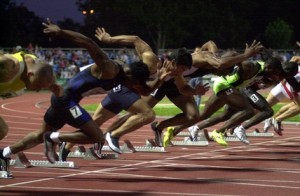Brian Schiff’s Blog
Injury Prevention, Sports Rehab & Performance Training Expert
Eliminating the “false step” has been a personal mission of many strength coaches I have heard or worked alongside of in my 15 year career. I used to wonder quietly why it was such a bad thing early on in my coaching. Based on angles and observation it seemed almost reflexive for most athletes.
Then a few years ago I had the privilege of seeing Lee Taft present his theory on speed development and multi-directional speed training and it all came together for me. Lee eloquently explained that the “false step” is really just a plyo step – a chance to load the body up for what it was meant to do. It essentially allows the athlete to reposition the body (or center of mass) more efficiently to load and explode. Ever wonder why sprinters use a starting block?

Look at all like an athlete’s body position once they step back and begin to move forward?
This topic has been covered in previous point/counterpoint articles in the NSCA journals and debated on forums, blogs and seminars alike. For me, I have been encouraging the “false step” or “plyo step” the past few years because it is ‘normal’ for athletes to move that way. As a matter of fact, one of the first things I do is put them in an athletic parallel stance position and ask them to accelerate for 10 yards. Not once have I seen them not step back provided I do not cue them to do so.
Keep in mind that previous research done (Kraan, GA, van Veen, J, Snijders, CJ, and Storm, J. Starting from standing: Why step backwards? J Biomech 34: 211–215, 2001.) indicates that stepping back is instinctive in up to 95% of subjects. Pretty telling, right? Even so, many coaches will still argue this technique slows the athletes down.

